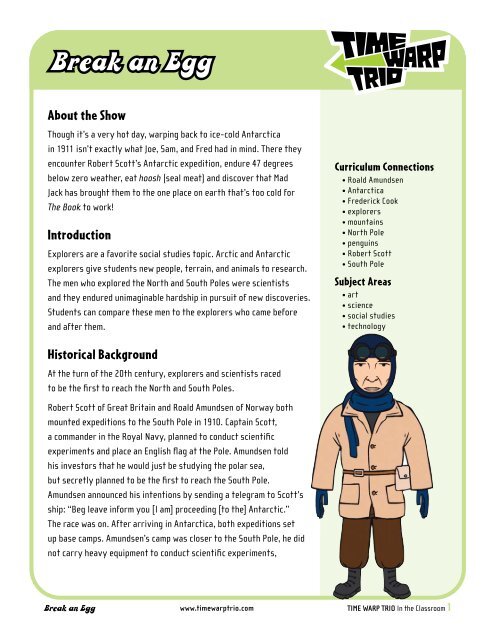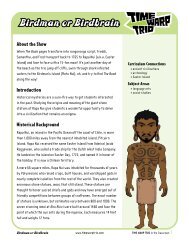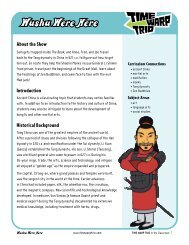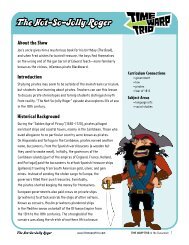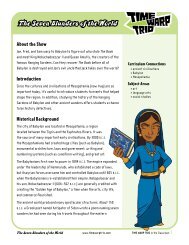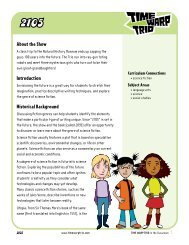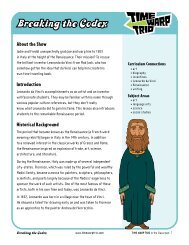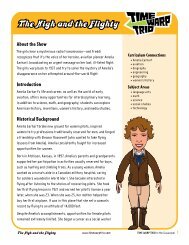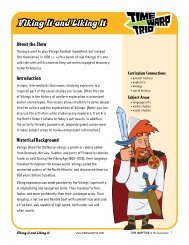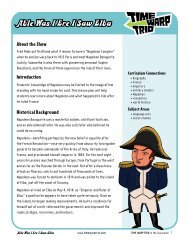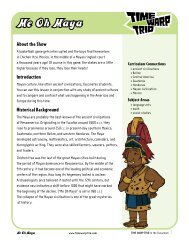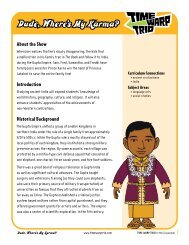Animals of Antarctica - Time Warp Trio
Animals of Antarctica - Time Warp Trio
Animals of Antarctica - Time Warp Trio
You also want an ePaper? Increase the reach of your titles
YUMPU automatically turns print PDFs into web optimized ePapers that Google loves.
Break an Egg<br />
About the Show<br />
Though it’s a very hot day, warping back to ice-cold <strong>Antarctica</strong><br />
in 1911 isn’t exactly what Joe, Sam, and Fred had in mind. There they<br />
encounter Robert Scott’s Antarctic expedition, endure 47 degrees<br />
below zero weather, eat hoosh (seal meat) and discover that Mad<br />
Jack has brought them to the one place on earth that’s too cold for<br />
The Book to work!<br />
Introduction<br />
Explorers are a favorite social studies topic. Arctic and Antarctic<br />
explorers give students new people, terrain, and animals to research.<br />
The men who explored the North and South Poles were scientists<br />
and they endured unimaginable hardship in pursuit <strong>of</strong> new discoveries.<br />
Students can compare these men to the explorers who came before<br />
and after them.<br />
Historical Background<br />
At the turn <strong>of</strong> the 20th century, explorers and scientists raced<br />
to be the first to reach the North and South Poles.<br />
Robert Scott <strong>of</strong> Great Britain and Roald Amundsen <strong>of</strong> Norway both<br />
mounted expeditions to the South Pole in 1910. Captain Scott,<br />
a commander in the Royal Navy, planned to conduct scientific<br />
experiments and place an English flag at the Pole. Amundsen told<br />
his investors that he would just be studying the polar sea,<br />
but secretly planned to be the first to reach the South Pole.<br />
Amundsen announced his intentions by sending a telegram to Scott’s<br />
ship: “Beg leave inform you [I am] proceeding [to the] Antarctic.”<br />
The race was on. After arriving in <strong>Antarctica</strong>, both expeditions set<br />
up base camps. Amundsen’s camp was closer to the South Pole, he did<br />
not carry heavy equipment to conduct scientific experiments,<br />
Break an Egg<br />
www.timewarptrio.com<br />
Curriculum Connections<br />
• Roald Amundsen<br />
• <strong>Antarctica</strong><br />
• Frederick Cook<br />
• explorers<br />
• mountains<br />
• North Pole<br />
• penguins<br />
• Robert Scott<br />
• South Pole<br />
Subject Areas<br />
• art<br />
• science<br />
• social studies<br />
• technology<br />
<strong>Time</strong> <strong>Warp</strong> <strong>Trio</strong> In the Classroom
Break an Egg<br />
Historical Background continued<br />
and he used dogs to pull his four sledges across the icecap. Able to travel quickly and carry less weight,<br />
Amundsen reached the South Pole on December 14, 1911.<br />
Before Scott set out for the Pole, three members <strong>of</strong> his team undertook a separate “Winter Journey”<br />
to Cape Crozier. In <strong>Antarctica</strong>, winter starts in March and is a time <strong>of</strong> continuous darkness. No one had<br />
ever attempted a journey during the Antarctic winter, but Apsley Cherry-Garrard, Edward Wilson, and<br />
Henry “Birdie” Bowers set out in the dark. Their purpose was to collect emperor penguin eggs—laid only<br />
in winter—in an attempt to understand the origin <strong>of</strong> birds. The men pulled their own sledges 67 miles<br />
from base camp to Cape Crozier in temperatures as low as minus seventy degrees. Although they nearly<br />
perished, they made it back to base camp with the samples they needed.<br />
Once the sun reappeared, Scott chose Wilson, Bowers, and several other men to accompany him<br />
for the final trek to the South Pole. Cherry-Garrard stayed behind. Scott tried using mechanical sledges<br />
to cross the ice. When these broke down, he had his men drag the heavy sledges themselves. After<br />
a valiant effort, Scott reached the Pole on January 17, 1912, only to find that Amundsen had gotten there<br />
before him. Tragically, Scott and his men died before they could return to their base camp.<br />
Break an Egg<br />
Want students to get even more<br />
excited about history?<br />
www.timewarptrio.com<br />
Check out the South pole adventure for kids at<br />
www.timewarptrio.com/adventures/southpole/<br />
Put It Back, Jack! and other interactive games to play.<br />
Plentifax 487—the ultimate time traveler’s guide—tells how the<br />
Antarctic explorers lived and worked.<br />
Cool Books that kids will love.<br />
<strong>Time</strong> <strong>Warp</strong> <strong>Trio</strong> In the Classroom
Activity<br />
Make a Diorama<br />
Students will research antarctic wildlife and create<br />
a diorama and fact sheet to present their research to<br />
the class.<br />
Instructions<br />
Break an Egg www.timewarptrio.com<br />
1<br />
. Have students research facts about <strong>Antarctica</strong>, including the wildlife<br />
<strong>of</strong> the region.<br />
. As a class, make a list <strong>of</strong> the animals indigenious to the region, such<br />
as emperor and other types <strong>of</strong> penguins, seabirds, whales, and seals.<br />
. Ask each student to choose an animal that lives in <strong>Antarctica</strong>.<br />
4. Each student will be making a diorama <strong>of</strong> a scene that shows the animal<br />
in its natural habitat. They will also create a fact sheet.<br />
5. Ask students to answer the questions on the “<strong>Animals</strong> <strong>of</strong> <strong>Antarctica</strong>”<br />
handout. Then have them attach the sheets to the dioramas.<br />
6. Ask students to present their dioramas by describing the scene they<br />
created and sharing facts about the animals they chose.<br />
7. Set up an exhibition <strong>of</strong> the dioramas in the classroom and invite other<br />
classes to come view your <strong>Antarctica</strong> Museum.<br />
Objectives<br />
• to practice research skills<br />
• to practice presentation skills<br />
Materials<br />
• art and writing supplies<br />
• modeling clay<br />
• shoebox for each student<br />
• “<strong>Animals</strong> <strong>of</strong> <strong>Antarctica</strong>” handout<br />
Curriculum Standards<br />
• NCSS<br />
People, Places, and Environments:<br />
Students interpret, use,<br />
and distinguish various<br />
representations <strong>of</strong> the earth<br />
such as maps, globes and<br />
photographs.<br />
• NCTe/ira<br />
Students employ a wide range<br />
<strong>of</strong> strategies as they write and<br />
use different writing process<br />
elements to appropriately<br />
communicate with different<br />
audiences for a variety <strong>of</strong> purposes.<br />
<strong>Time</strong> <strong>Warp</strong> <strong>Trio</strong> In the Classroom
<strong>Animals</strong> <strong>of</strong> <strong>Antarctica</strong> Fill in the information about your animal then attach this handout to your diorama.<br />
• Name <strong>of</strong> animal<br />
• Where does it live?<br />
• What does it eat?<br />
• What type <strong>of</strong> shelter does it require?<br />
• How does it breed?<br />
• What interesting behaviors does it exhibit?<br />
• Is the animal threatened or endangered? Explain.<br />
Break an Egg www.timewarptrio.com <strong>Time</strong> <strong>Warp</strong> <strong>Trio</strong> In the Classroom<br />
© 2006 WGBH Educational Foundation.
Activity<br />
2<br />
Explorer’s Journal<br />
in “Break an egg,” Joe, Fred, and Sam encounter the explorer<br />
apsley Cherry-Garrard on his “Winter Journey” to Cape Crozier.<br />
The <strong>Trio</strong> help Cherry-Garrard on his quest to find emperor<br />
penguin eggs. much <strong>of</strong> what is known about antarctic expeditions<br />
comes from the journals <strong>of</strong> the explorers themselves. Students<br />
will enjoy creating a journal <strong>of</strong> their own.<br />
Instructions<br />
. Discuss the organization, structure, and characteristics <strong>of</strong> an explorer’s<br />
journal. Point out that explorers were <strong>of</strong>ten scientists trying to provide<br />
detailed descriptions <strong>of</strong> the new lands and animals they encountered.<br />
Show students samples <strong>of</strong> journal entries from various explorers.<br />
For example, you may want to use the journals <strong>of</strong> Lewis and Clark.<br />
. Working individually or in pairs, have students research a specific<br />
expedition, led by Peary, Scott, Amundsen, Shackleton, or Mawson.<br />
. Have each student write a journal entry (with an illustration or collage)<br />
from the point <strong>of</strong> view <strong>of</strong> a team member on a specific expedition. They must<br />
incorporate at least five facts they have learned about the expedition into<br />
their writing.<br />
4. Collect and copy the journal entries and create a class book for students<br />
to enjoy.<br />
Break an Egg www.timewarptrio.com<br />
Objectives<br />
• to practice research skills<br />
• to use a journal format<br />
Materials<br />
• art and writing supplies<br />
• one piece <strong>of</strong> white construction<br />
paper per student (9” X 12”)<br />
Curriculum Standards<br />
• NCSS<br />
Individuals, Groups, & Institutions:<br />
The students will analyze<br />
examples <strong>of</strong> conflict, cooperation,<br />
and interdependence among<br />
groups, societies, and nations.<br />
• NCTe/ira<br />
Students employ a wide range<br />
<strong>of</strong> strategies to comprehend,<br />
interpret, evaluate, and<br />
appreciate texts.<br />
<strong>Time</strong> <strong>Warp</strong> <strong>Trio</strong> In the Classroom 5
Resources<br />
Recommended Books<br />
For Teachers<br />
antarctica: The Blue Continent<br />
by David McGonigal and Dr. Lynn<br />
Woodworth. (Firefly Books Ltd, 2003)<br />
This beautifully illustrated guide<br />
to <strong>Antarctica</strong> tells the tales <strong>of</strong> the<br />
explorers who tried to conquer<br />
this frozen land.<br />
Cherry: a Life <strong>of</strong> apsley Cherry-<br />
Garrard by Sara Wheeler,<br />
(Random House, 2002)<br />
Using excerpts from Cherry-Garrard’s<br />
book, The Worst Journey in the<br />
World, as well as accounts from the<br />
other men on the voyage, this tells<br />
<strong>of</strong> Cherry-Garrard’s adventures.<br />
penguins <strong>of</strong> the World by Wayne<br />
Lynch. (Firefly Books Ltd, 1997)<br />
This book contains numerous facts<br />
and beautiful photographs <strong>of</strong> various<br />
species <strong>of</strong> penguins.<br />
Tom Crean: Unsung Hero <strong>of</strong> the<br />
Scott and Shackleton antarctic<br />
expeditions by Michael Smith.<br />
(Mountaineers Books, 2002)<br />
Tom Crean accompanied explorers<br />
Scott and Shackleton on journeys<br />
to <strong>Antarctica</strong>, but received little or<br />
no recognition for it.<br />
The Worst Journey in the World<br />
by Apsley Cherry-Garrard<br />
(Stackpole Books, 2001)<br />
As the only surviving member<br />
<strong>of</strong> Scott’s attempt to be the first<br />
explorer to the South Pole, Cherry-<br />
Garrard gives a detailed account<br />
<strong>of</strong> the extraordinary trip he took<br />
to recover emperor penguin eggs.<br />
For Students<br />
Fiction<br />
The antarctic Scoop by Lucy Jane<br />
Bledsoe. (Holiday House, 2003)<br />
Victoria is miserable—her parents<br />
are divorced and she gets teased for<br />
being a science geek. When she gets<br />
a chance to go to <strong>Antarctica</strong>, she<br />
doesn’t realize that it is the chance<br />
<strong>of</strong> a lifetime.<br />
Gus and Gertie and the Lucky<br />
Charms by Joan Lowery Nixon.<br />
(SeaStar Books, 2001)<br />
Two hopeful penguins, Gus and Gertie,<br />
arrive at the Olympics only to find<br />
that there is no synchronized swim<br />
event in the winter games!<br />
The Little penguin by A. J. Wood.<br />
(Dutton, 2001)<br />
As a baby penguin heads for the sea,<br />
he gets separated from his family<br />
and worries that he may never get all<br />
the way to the ocean.<br />
Break an Egg www.timewarptrio.com<br />
mr. popper’s penguins<br />
by Richard and Florence Atwater.<br />
(Little Brown, 1938)<br />
In this modern classic, Mr. Popper<br />
is a house painter who dreams <strong>of</strong><br />
traveling the world but ends up<br />
with 12 penguins instead.<br />
penguin puzzle by Judith Bauer<br />
Stamper. (Scholastic, 2001)<br />
The Magic School Bus series.<br />
Ms. Frizzle and the gang travel<br />
to <strong>Antarctica</strong>.<br />
Something to Tell the Grandcows<br />
by Eileen Spinelli. (Eerdmans, 2004)<br />
Emmadine the cow travels to the<br />
South Pole with Admiral Byrd and she<br />
returns with great stories to tell. For<br />
younger readers.<br />
The Stone idol by Franklin W. Dixon.<br />
(Simon & Schuster, 1981)<br />
The Hardy Boys series. Amateur<br />
detectives Joe and Frank Hardy are<br />
tracking a stolen sculpture when<br />
they receive an emergency call from<br />
their father. He is investigating a spy<br />
ring in <strong>Antarctica</strong> and needs help.<br />
<strong>Time</strong> <strong>Warp</strong> <strong>Trio</strong> In the Classroom 6
Resources<br />
Nonfiction<br />
after the Last Dog Died: the True-<br />
Life, Hair-raising adventure <strong>of</strong><br />
Douglas mawson and His 1911–1914<br />
antarctic expedition<br />
by Carmen Bredeson.<br />
(National Geographic, 2003)<br />
In 1911, an Australian geology<br />
teacher turned polar explorer led<br />
a scientific expedition to map the<br />
interior <strong>of</strong> <strong>Antarctica</strong>.<br />
antarctic Journal, Four months at<br />
the Bottom <strong>of</strong> the World by Jennifer<br />
Owings Dewey. (HarperCollins, 2001)<br />
Diary entries, letters home,<br />
sketches and color photographs<br />
record Dewey’s time at the science<br />
labs at Palmer Station on Anvers<br />
Island on <strong>Antarctica</strong>.<br />
antarctica by Kelly McDonald.<br />
(Heinemann, 1997)<br />
Great Journeys series. Explores<br />
the history and geography<br />
<strong>of</strong> <strong>Antarctica</strong>, details several <strong>of</strong><br />
the South Pole expeditions, and<br />
provides information about emperor<br />
penguins and other animals that<br />
live in the region.<br />
arctic & antarctic by Barbara Taylor.<br />
(Knopf, 1995)<br />
Eyewitness Books series. Information<br />
on the sea life, animals, and plants<br />
that live in two <strong>of</strong> the most extreme<br />
climates on earth, as well as the<br />
humans who live in and explore the<br />
North and South Poles.<br />
Greetings from antarctica by Sara<br />
Wheeler. (Peter Bedrick Books, 1999)<br />
Letters to her godson and her<br />
own photographs tell about Sara<br />
Wheeler’s experiences in <strong>Antarctica</strong>.<br />
icy antarctic Waters by Wendy<br />
Pfeffer. (Marshall Cavendish, 2003)<br />
Close-up photographs describe the<br />
animals and sea creatures that live<br />
in and near the freezing sea around<br />
<strong>Antarctica</strong>. For younger readers.<br />
polar explorers by Stephen Currie.<br />
(Lucent Books, 2002)<br />
Short biographies and accounts <strong>of</strong><br />
the travels <strong>of</strong> five explorers <strong>of</strong> the<br />
“golden age” <strong>of</strong> polar exploration.<br />
poles apart by Elaine Scott.<br />
(Viking, 2004)<br />
This book explores the evolution,<br />
history, and scientific importance<br />
<strong>of</strong> the two regions.<br />
The race to the South pole<br />
by Rupert Mathews.<br />
(Bookwright Press, 1989)<br />
Details the many attempts <strong>of</strong><br />
explorers (including Amundsen,<br />
Scott, and Shackleton) to be the<br />
first to reach the South Pole.<br />
roald amundsen by Enid Broderick.<br />
(World Almanac Library, 2002)<br />
Norwegian Roald Amundsen found<br />
himself locked in a race with Robert<br />
Scott to be the first person to reach<br />
the South Pole.<br />
Break an Egg www.timewarptrio.com<br />
robert Scott, British explorer <strong>of</strong><br />
the South pole by John Riddle and<br />
Robert Ingpen. (Mason Crest, 2003)<br />
Scott was determined to reach<br />
the South Pole before Amundsen,<br />
but a series <strong>of</strong> poor decisions,<br />
miscalculations, and bad weather<br />
turned the expedition into a tragedy.<br />
Shipwreck at the Bottom <strong>of</strong> the<br />
World: The extraordinary Story <strong>of</strong><br />
Shackleton and the endurance<br />
by Jennifer Armstrong. (Crown, 1998)<br />
When Ernest Shackleton’s expedition<br />
ends in 1916, Shackleton and his<br />
crew, despite incredible odds, have<br />
survived their ordeal in <strong>Antarctica</strong>.<br />
Poetry<br />
antarctic antics: a Book <strong>of</strong> penguin<br />
poems by Judy Sierra. (Harcourt, 1998)<br />
A collection <strong>of</strong> ten light and humorous<br />
poems and three riddles, based on the<br />
lives and habits <strong>of</strong> emperor penguins.<br />
<strong>Time</strong> <strong>Warp</strong> <strong>Trio</strong> In the Classroom 7
Resources<br />
Web Sites<br />
aNTarCTiC expLorerS<br />
www.enchantedlearning.com/<br />
explorers/antarctica.shtml<br />
Brief, kid-friendly information about<br />
many Arctic and Antarctic explorers.<br />
aNTarCTiCa piCTUreS,<br />
iNFormaTioN, aND TraveL<br />
www.coolantarctica.com<br />
Provides photographs and facts<br />
about <strong>Antarctica</strong>, including animals,<br />
climate, and explorers <strong>of</strong> the region.<br />
arCTiC aND aNTarCTiC HiSTory<br />
oN THe NeT<br />
www.south-pole.com<br />
Detailed biographies <strong>of</strong> South Pole<br />
explorers, including Robert F. Scott<br />
and Roald Amundsen, plus excerpts<br />
from letters sent by the explorers.<br />
emperor peNGUiN priNToUT<br />
www.enchantedlearning.com/<br />
subjects/birds/printouts/<br />
Provides labeled drawing <strong>of</strong> and<br />
detailed information about emperor<br />
penguins. Scroll down until the<br />
emperor penguin illustration appears.<br />
emperor peNGUiNS<br />
www.nationalgeographic.com/<br />
kids/creature_feature/0101/<br />
penguins2.html<br />
Explore links to penguin information,<br />
fun facts, a video, and articles from<br />
National Geographic Kids.<br />
NeW SoUTH poLar <strong>Time</strong>S<br />
205.174.118.254/nspt/home.htm<br />
This newsletter, written by the<br />
staff <strong>of</strong> the Amundsen-Scott<br />
South Pole Station, provides<br />
students and teachers with<br />
information on <strong>Antarctica</strong>, scientific<br />
research, and life at the station.<br />
Some aNTarCTiC QUoTeS<br />
www.antarctic-circle.org/<br />
quotes.htm<br />
Contains quotes from polar<br />
explorers, including Apsley Cherry-<br />
Garrard, leader <strong>of</strong> the “Winter<br />
Journey” to Cape Crozier.<br />
please note:<br />
Although these sites were verified at the time<br />
<strong>of</strong> publication, Web site addresses and content<br />
are frequently subject to change.<br />
©2006 WGBH Educational Foundation. All rights reserved. <strong>Time</strong> <strong>Warp</strong> <strong>Trio</strong> is produced by WGBH in association with Soup2Nuts for Discovery Kids. Major funding was provided by a grant from<br />
the National Endowment for the Humanities. Any views, findings, conclusions, or recommendations expressed in these classroom materials do not necessarily represent those <strong>of</strong> the National<br />
Endowment for the Humanities. Based on THE TIME WARP TRIO book series written by Jon Scieszka and illustrated by Lane Smith. <strong>Time</strong> <strong>Warp</strong> <strong>Trio</strong> is a registered trademark <strong>of</strong> Chucklebait, LLC.<br />
Used with permission. Third party trademarks are the property <strong>of</strong> their respective owners. Used with permission.<br />
Break an Egg www.timewarptrio.com<br />
<strong>Time</strong> <strong>Warp</strong> <strong>Trio</strong> In the Classroom 8


